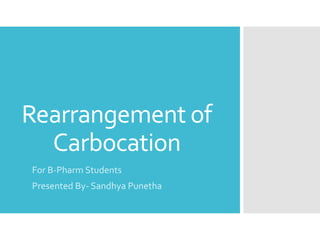
Rearrangement of carbocation
- 1. Rearrangement of Carbocation For B-Pharm Students Presented By- Sandhya Punetha
- 2. Carbocation A carbocation is molecule in which a carbon atom bears three bond with a positive charge. Carbocations are usually unstable because they do not have eight electrons to satisfy the octet rule. It generate through heterolysis fusion - C:𝑍− - 𝐶+ + 𝑍:−
- 3. Important Facts All carbocations are known as carbonium ions. Some carbocations may have 2 or more positive charge on carbon atom.
- 4. Classification of carbocations Primary Carbocations- It is one in which there is one carbon group attached to the carbon bearing the positive charge. Eg- H 𝐶𝐻3 𝐶+ H Secondary Carbocations- It is one in which there is two carbon group attached to the carbon bearing the positive charge. Eg- H 𝐶𝐻3 𝐶+ 𝐶𝐻3 Tertiary Carbocations- It is one in which there is three carbon group attached to the carbon bearing the positive charge.
- 5. Eg- 𝐶𝐻3 𝐶𝐻3 𝐶+ 𝐶𝐻3 Allylic Carbocation- The carbon bearing the positive charge is immediately adjacent to a carbon-carbon double bond, this type of carbocation is known as allylic carbocation. Eg- 𝑪𝑯 𝟐 𝐶+ 𝐻2
- 6. Benzylic Carbocation- If the carbon bearing the positive charge is immediately adjacent to the benzene ring the carbocation is termed as benzylic carbocation. Eg- H 𝑪+ H Vinyl Carbocation- If the carbon bearing the positive charge is part of alkene is called vinyl carbocation. Eg- C𝑯 𝟐= 𝑪+- H
- 7. Phenyl Carbocations- If the carbon bearing the positive charge is a part of a benzene ring, the carbocation is termed as an aryl or phenyl carbocation. Eg- +
- 8. Structure of Carbocation The structure of carbocations is trigonal planar. A stylized orbital structure of the methyl cation.The bonds are sigma bonds formed by overlap of the carbon atoms 3 𝑠𝑝2 orbitals with 1s orbitals of the hydrogen atoms.The p orbital is vacant. A dashed line-wedge representation of the tert-butyl cation.The bonds between carbon atoms are formed by overlap of 𝑠𝑝2orbitals of the central carbon atom.
- 9. Rearrangement of Carbocation The bonding electrons of a carbocation may shift between adjacent atoms to form a more stable carbocation. Eg- Rearrangement will occur if a secondary carbocation can be formed from a primary carbocation because a secondary carbocation is more stable than the primary carbocation. Types of shift-
- 10. Of these two rearrangement examples hydride shift leads to a tertiary carbocation whereas alkyl shift leads to a secondary carbocation, the hydride shift is favored in preference to the alkyl shift. Any C-H or C-C bond adjacent to a carbocation may shift , but onlyC-C and C-H bonds can migrate during carbocation rearrangement. The most common carbocation rearrangement involve a carbocation rearranging into a more stable carbocation such as, secondary to tertiary with a resonance. Rearrangements that transform a carbocation into another of apparently equal stability are less common , but they do occur. Rearrangement to a less stable carbocation is very unusual , but also does occur.
- 11. Factors affecting stability in carbocation Factors that destabilize the carbocations are- 1) Effect of substitution 2) Neighboring electron withdrawing groups 3) Hybridisation
- 12. 1) Effect of substitution The stability of carbocation decreases as the number of carbons attached to the carbocation decreases. Stability of carbocation- Tertiary > Secondary> Primary Explanation-The methyl group acts as an electron donor and therefore stabilizes the positively charged cation and as well as due to hyperconjugation.
- 13. 2) Neighbouring electron withdrawing group If there will be the presence of any electron withdrawing group with the carbocation than inductive effect may occur. The greater the number of electron withdrawing group less will be the stability. The donation or withdrawal of electrons through a sigma bond is called as inductive effect.
- 14. 3) Hybridisation The stability of carbocation decreases as it moves from 𝑠𝑝3 > 𝑠𝑝2 > sp .
- 15. THANK YOU “You never fail until you stop trying”….